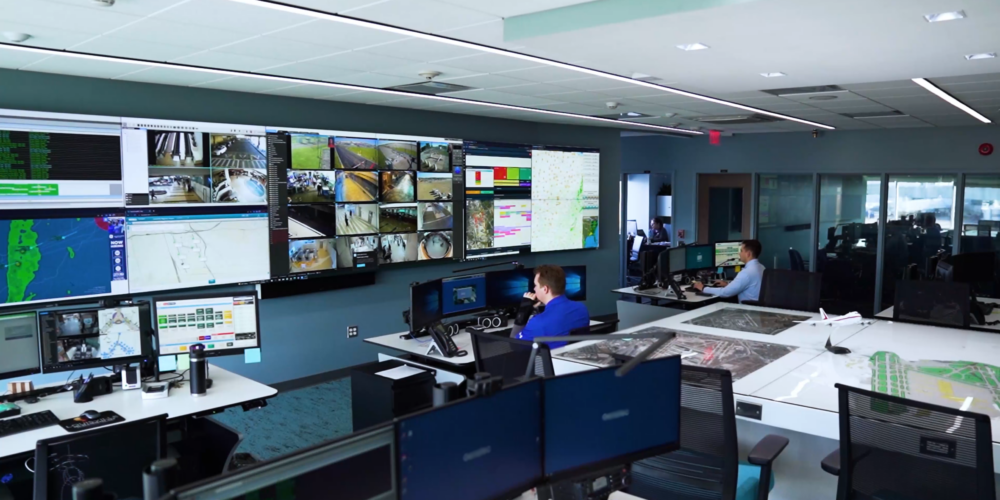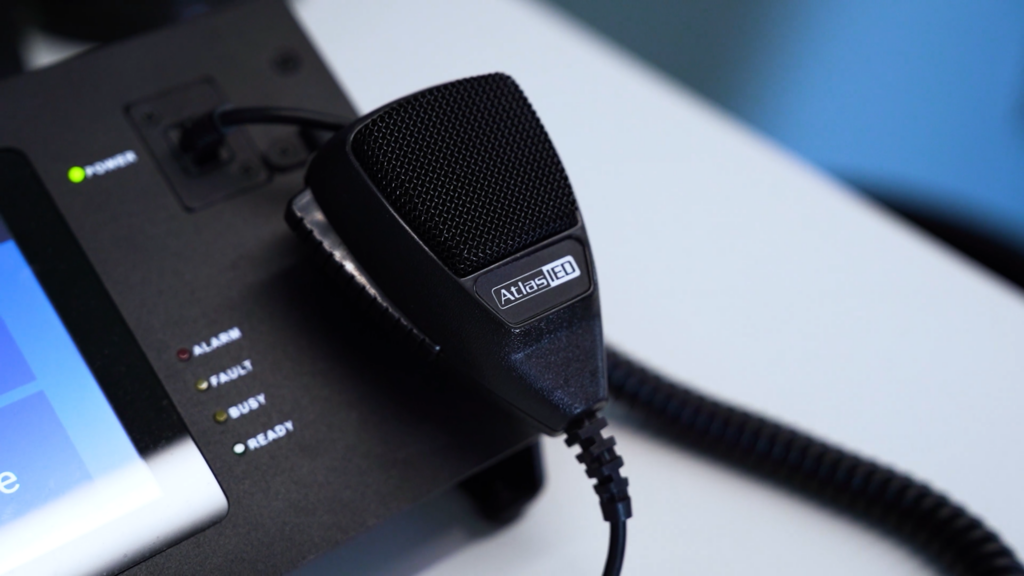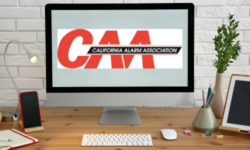Achieving Critical Mass Communication During Emergencies
How to interconnect mass communication and fire evacuation systems for faster response, meeting fire codes, adhering to ADA regs and more.

Photo courtesy of AtlasIED
Fire evacuation systems often trigger automatic notifications to first responders that an emergency is in progress while also activating audible and visual alarms within the building. However, those alarms are often indicators only because they don’t provide context to the nature or location of the emergency.
Mass communication systems can provide valuable information and instructions for helping lead people to safety.
For example, if a situation occurs in the south end of the building that requires an evacuation, a mass communication system can safely direct people away from exits in the southern section, which also keeps entry points clear of civilians when first responders arrive and assess the situation.
Following are five benefits of integrating a fire evacuation system with a mass communication system to enhance people’s safety and well-being:
Simplified Integration
Different vendors often manage disparate systems and require separate installation teams, training and support. At the pace of today’s business, having multiple vendors when system consolidation and collaboration are possible simply isn’t cost-effective.
And if a technical difficulty occurs, inevitably, it’s “the other system’s fault,” which leads to prolonged troubleshooting sequences and higher installation and maintenance costs.
Fire alarm control units typically use either contact closures (relays) with open/close states or an addressable output module, which can provide more granular options for response conditions rather than just “on/off.”
For example, if a building has electronically closable fire doors, then specific doors can be opened or closed depending on the input to the control module.
Robust mass communication systems often support contact closure and addressable outputs from the fire alarm panel. They can trigger internal announcements automatically based on the information received from the fire panel.
Faster Response Times
When people typically think about response time, it’s usually in the context of first responders’ time to arrive onsite, which is extremely important. However, the flipside of that sentiment is how long it takes to evacuate or lock down affected personnel.
Almost everyone who hears a fire alarm assumes it’s a drill or was triggered by accident, so there’s no impetus to move quickly. It’s more of a hassle to leave than a serious concern, and some people may choose not to leave their office at all.
In cases of an actual emergency, this puts additional responsibility on first responders to first check for people and get them to safety vs. addressing the emergency itself.
Mass communication systems can provide context to the nature of the alarm, indicating that it’s not a drill or accidental trigger. Knowing it’s not a drill, people will have heightened emotions about getting to safety, so the mass communication system can provide reminders for proceeding carefully and not to panic.
Likewise, alarm tests can be announced beforehand, informing occupants that they do not have to leave the building or creating unnecessary experiences for individuals that don’t respond well to loud noises or visual flashers.
Coordinated Communications
Emergency scenarios have an inherent chaotic aspect, and often the first area to suffer during the chaos and uncertainty is quality communication among rescue teams, security personnel and others.
Considerations for communication include the number of people that need to be notified, trained employees versus transient public, staff capabilities and the extent of notification (there may be different first responders for different events).
Every second counts in emergency scenarios, so having a communication system everyone can tap into can significantly reduce confusion caused by using disparate systems and not having everyone on the same page.
For example, once first responders are on site, they can use a mass communication system to communicate with anyone forced to shelter in place or broadcast an “all clear” notification when it’s safe for everyone to re-enter the building.

Photo courtesy of AtlasIED
Adherence to Fire Codes
The National Fire Alarm and Signaling Code, commonly known as NFPA 72, is a widely recognized standard developed and published by the National Fire Protection Association (NFPA) for designing, installing, inspecting, testing and maintaining fire alarm systems.
This code provides the minimum requirements for fire alarm systems, including their components and accessories, to protect life and property from fire and other hazards. The standard is updated every three years to reflect the latest research and best practices in fire safety.
Once the application of NFPA 72 expanded beyond just fire safety, it was recognized that there are many types of emergency events that a communication system can be designed to address. For example, occupants must be given different instructions for a fire emergency versus an emergency requiring shelter-in-place actions,
Hence, Chapter 24 of NFPA 72 was added to document the requirements that apply to emergency communications systems.
A key requirement for mass notification systems is that they are designed according to the nature and anticipated risk of the facility being protected. For example, a lab that regularly uses volatile chemicals may have additional mass communication requirements compared to a warehouse, given the nature of the business.
NFPA 72 requires a risk analysis to address fire and nonfire events, the nature of the hazards, occupancy characteristics, and facility characteristics. Nonfire events include security issues, environmental hazards and severe weather events.
ADA Compliance
The Americans with Disabilities Act (ADA) is a civil rights law that prohibits discrimination against individuals with disabilities in all public and private places open to the general public. The purpose of the law is to ensure that people with disabilities have the same rights and opportunities as everyone else.
One outcome of the ADA was the creation of the Americans with Disabilities Act Accessibility Guidelines (ADAAG), and section 4.28 of the ADAAG specifically outlines guidelines for fire alarm systems.
However, the requirements within NFPA 72 are more stringent than those outlined in the ADAAG, so any buildings compliant with NFPA 72 should also meet or exceed the standards set in the ADAAG.
That said, ADAAG requires all fire alarm systems to allow for equal access, which puts restrictions and requirements on the brightness, placement, and frequency of notification devices.
Per ADAAG, there are three areas required for fire alarm systems: 1) signaling for those with hearing impairments; 2) signaling for those with visual impairments; and 3) access to manual fire alarm pull stations for those with physical impairments.
However, neither ADAAG nor NFPA 72 regulates the content of those alarms — whether audible words or visual imagery can be used in conjunction with alarm sounds or visual flashers. With a mass communication system, you can include messaging about the nature of the alarm (fire, lockdown, chemical spill, etc.) with appropriate safety information.
Additionally, that information can be displayed or broadcast in multiple languages to benefit multicultural audiences often encountered in public places like airports.
Final Thoughts
Mass communication systems can be very beneficial during daily business operations and emergencies. Integrating mass communications with fire evacuation systems is the natural evolution for extending each system’s capabilities for protecting people and property when situations occur.
Integrators can benefit greatly from researching security manufacturers’ offerings to understand the options for integrating alarm and communication systems.
Alex Purro is vice president of IP endpoints for AtlasIED.
If you enjoyed this article and want to receive more valuable industry content like this, click here to sign up for our FREE digital newsletters!

Security Is Our Business, Too
For professionals who recommend, buy and install all types of electronic security equipment, a free subscription to Commercial Integrator + Security Sales & Integration is like having a consultant on call. You’ll find an ideal balance of technology and business coverage, with installation tips and techniques for products and updates on how to add to your bottom line.
A FREE subscription to the top resource for security and integration industry will prove to be invaluable.







